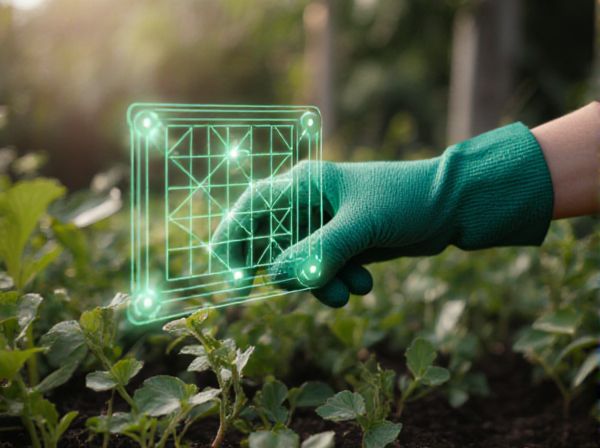
Photosynthetic Rate vs Photoinhibition Illustration
Sunlight drives the photosynthetic rate by providing the energy plants need to convert carbon dioxide and water into glucose and oxygen. However, excessive sunlight can lead to photoinhibition, a decline in photosynthesis caused by damage to the photosynthetic apparatus, particularly Photosystem II. Balancing light intensity is crucial for maximizing photosynthetic efficiency while minimizing harmful photoinhibition effects.
Table of Comparison
| Aspect | Photosynthetic Rate | Photoinhibition |
|---|---|---|
| Definition | Speed at which plants convert light into chemical energy | Reduction in photosynthetic efficiency due to excess light |
| Light Intensity | Increases with moderate to optimal sunlight | Occurs under excessive or intense sunlight |
| Effect on Plant | Enhances growth and biomass production | Damages photosynthetic apparatus, reducing growth |
| Duration | Occurs during daylight under ideal conditions | Occurs after prolonged exposure to high light |
| Biological Mechanism | Light energy drives photosystems I and II | Excess energy causes photodamage to photosystem II |
| Mitigation | Optimizing light exposure and CO2 levels | Photoprotection via carotenoids and repair processes |
Understanding Photosynthetic Rate in Plants
Photosynthetic rate in plants represents the efficiency at which chloroplasts convert light energy into chemical energy, primarily influenced by light intensity. At optimal light conditions, the rate increases, promoting growth and biomass accumulation. However, excessive sunlight triggers photoinhibition, damaging photosystem II and reducing photosynthetic output, thereby limiting plant productivity.
Defining Photoinhibition in Gardening Context
Photoinhibition in gardening refers to the decline in photosynthetic rate when plants are exposed to excess sunlight beyond their optimal light saturation point, causing damage to the photosystem II complexes. This excessive light energy impairs the chloroplast's functionality, leading to reduced carbon dioxide assimilation and compromised plant growth. Understanding photoinhibition helps gardeners balance sunlight exposure to maximize photosynthetic efficiency and prevent light-induced stress.
Sunlight Intensity and Photosynthetic Efficiency
Sunlight intensity directly influences photosynthetic rate by providing the energy necessary for chlorophyll to convert carbon dioxide and water into glucose and oxygen. At optimal sunlight levels, photosynthetic efficiency peaks, maximizing energy absorption and biomass production. Excessive sunlight intensity triggers photoinhibition, damaging the photosynthetic apparatus and reducing overall photosynthetic efficiency.
How Excess Sunlight Leads to Photoinhibition
Excess sunlight causes photosynthetic machinery to absorb more light energy than it can process, resulting in the generation of reactive oxygen species that damage chloroplast components. This imbalance between light absorption and utilization triggers photoinhibition, reducing the photosynthetic rate by impairing photosystem II efficiency. Protective mechanisms such as non-photochemical quenching activate to dissipate excess energy, but prolonged exposure to intense light ultimately inhibits photosynthetic performance and plant growth.
Factors Affecting Photosynthetic Rate in Gardens
Photosynthetic rate in gardens is primarily influenced by light intensity, with optimal levels promoting maximum carbon fixation and growth while excessive sunlight induces photoinhibition, damaging chlorophyll and reducing efficiency. Temperature, water availability, and nutrient status also significantly impact the balance between photosynthesis and photoinhibition, affecting overall plant health. Shade management and species selection based on light tolerance are essential strategies to optimize photosynthetic performance and minimize photoinhibition in garden environments.
Balancing Light Exposure for Optimal Plant Growth
Photosynthetic rate increases with light intensity up to a species-specific saturation point, beyond which photoinhibition occurs, damaging the photosynthetic apparatus and reducing efficiency. Optimal plant growth requires balancing light exposure to maximize photosynthesis while minimizing photodamage, achieved through adaptive mechanisms like non-photochemical quenching and chloroplast movement. Managing light intensity and duration in controlled environments enhances crop yield by preventing excessive light stress and maintaining photosystem II functionality.
Symptoms of Photoinhibition in Common Garden Plants
Photoinhibition in common garden plants manifests through symptoms such as leaf chlorosis, reduced photosynthetic rate, and wilting, indicating impaired photosystem II efficiency. Excessive sunlight leads to the accumulation of reactive oxygen species, causing damage to chloroplast membranes and pigment degradation. These symptoms reduce the plant's capacity for carbon fixation, directly impacting growth and overall plant health under high light stress conditions.
Strategies to Mitigate Photoinhibition in the Garden
Optimizing photosynthetic rate while minimizing photoinhibition in garden plants involves using shade nets and selective pruning to regulate sunlight exposure. Incorporating species with high photoprotective pigments such as carotenoids enhances resilience against excessive light stress. Applying anti-transpirants and maintaining adequate soil moisture further mitigates photodamage, promoting sustained photosynthetic efficiency.
Comparing Shade-Tolerant vs Sun-Loving Plants
Shade-tolerant plants exhibit a lower photosynthetic rate under high light conditions due to increased susceptibility to photoinhibition, whereas sun-loving plants maximize photosynthetic efficiency with minimal photodamage in intense sunlight. The photoinhibition threshold in shade-tolerant species occurs at significantly lower light intensities, leading to reduced carbon assimilation and growth compared to sun-adapted counterparts. Sun-loving plants possess enhanced photoprotective mechanisms such as efficient xanthophyll cycle activity and antioxidant enzyme systems that mitigate light-induced stress, optimizing photosynthesis across a broader light spectrum.
Practical Tips for Managing Sunlight in Home Gardens
Managing sunlight in home gardens requires balancing photosynthetic rate and photoinhibition to maximize plant health and growth. Use shade cloths or strategically position plants to prevent excessive light exposure that can reduce photosynthetic efficiency and cause photoinhibition. Regularly monitor plant stress signs and adjust light levels with pruning or relocating to optimize sunlight for photosynthesis without triggering damage.
Photosynthetic Rate vs Photoinhibition Infographic

 gardendif.com
gardendif.com